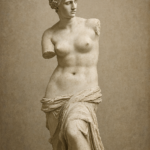
“The Thinker,” a bronze masterpiece crafted by the renowned artist Auguste Rodin, typically rests upon a sturdy stone pedestal. This iconic sculpture portrays a larger-than-life, nude male figure in a contemplative posture, seated atop a rocky surface. The subject is captured in a moment of deep introspection, leaning forward with their right elbow gracefully supported by their left thigh, while the weight of their chin gently rests upon the back of their right hand.
“The Thinker” originated as part of a larger sculptural masterpiece called “The Gates of Hell,” a project conceived by the French artist Auguste Rodin in 1880. This monumental work was commissioned for a decorative arts museum in Paris and was meant to adorn its doors. The sculpture of “The Thinker” was just one element among many in this grand composition, representing the writer Dante Alighieri in deep contemplation.
Initially, Rodin referred to the iconic sculpture as “The Poet” rather than “The Thinker.” Its original purpose was to symbolize Dante Alighieri, the author of “The Divine Comedy.” Rodin’s choice to depict a thinking figure, perched on a rock with his chin resting on his hand, captures the essence of intellectualism and the profound act of contemplation.
“The Thinker” has become a universally recognized symbol of intellectual activity and the human capacity for deep thought and introspection. This sculpture, standing at approximately 28 inches (71 centimeters) in height, is known for its intricate details and the intense expression of concentration on the subject’s face. Rodin’s artistry in sculpting this figure is renowned for its ability to convey the complexity of the human mind through the medium of bronze.
The first full-sized bronze cast of “The Thinker” was finally completed in 1902. This cast marked a significant step in the sculpture’s journey from concept to reality and allowed the world to appreciate its intricate design and symbolism. Over time, the sculpture evolved from its initial mixed reviews to become one of the most famous and enduring sculptures in the world.
The original purpose of “The Thinker” was to sit atop the decorative arts museum in Paris, serving as a representation of Dante Alighieri pondering the inferno described in “The Divine Comedy.” This placement would have made it a key element of the museum’s architectural design, highlighting the importance of intellectual pursuits in the realm of art.
Auguste Rodin was not content with just one version of “The Thinker.” He created multiple casts, each with varying sizes and materials, allowing for a variety of interpretations and artistic expressions of the same subject. These diverse versions of the sculpture can be found in museums and collections worldwide, showcasing Rodin’s creativity and adaptability.
The original unveiling of “The Thinker” in 1888 garnered mixed reviews from the art world. While some praised its depth and symbolism, others questioned its relevance and connection to the larger work, “The Gates of Hell.” Over time, as “The Thinker” gained recognition and notoriety, it became clear that Rodin had created a masterpiece that transcended the confines of its original context.
“The Thinker” is celebrated for its portrayal of intense concentration and introspection. The sculpture’s facial expression and body language convey a sense of deep thought and intellectual exploration, inviting viewers to contemplate the human capacity for independent thinking and reflection.
Among the various casts of “The Thinker,” the one located at the Musée Rodin in Paris is arguably the most famous and visited. This specific cast has become synonymous with the sculpture and is a must-see for art enthusiasts visiting the French capital.
Rodin’s intention with “The Thinker” was to symbolize the profound intellectual and artistic struggles faced by creative individuals. The sculpture serves as a reminder of the dedication and contemplation that go into the creative process, making it a poignant representation of human ingenuity and the pursuit of knowledge.
The original concept for “The Thinker” involved its placement above the doors of a decorative arts museum in Paris. This location would have connected the sculpture to the broader theme of creativity and intellectualism, emphasizing its significance as a symbol of thoughtful contemplation.
“The Thinker” was envisioned by Rodin as a representation of Dante Alighieri contemplating the inferno described in his epic poem, “The Divine Comedy.” Rodin’s choice of subject matter and the sculpture’s placement highlighted the intersection of art and literature.
Over time, more than 20 original casts of “The Thinker” were created, varying in size and material. These casts were distributed to museums, institutions, and private collections worldwide, further cementing the sculpture’s global prominence and influence.
While “The Thinker” is celebrated today, it initially received mixed reviews when it was first exhibited in 1888. Some critics questioned its connection to the larger work, “The Gates of Hell,” while others praised its portrayal of deep thought and intellectual exploration.
The intense expression on the face of “The Thinker” is often described as one of profound concentration and introspection. This meticulous attention to detail in the sculpture’s facial features and body language contributes to its enduring appeal and recognition.
“The Thinker” draws inspiration from both the Italian Renaissance and classical sculpture. Rodin’s fascination with these artistic traditions influenced his approach to capturing the human form in a state of deep contemplation.
“The Thinker” has left an indelible mark on art and popular culture. It has been referenced and parodied in various forms of media, literature, and films, highlighting its enduring impact and iconic status.
In 1906, a large-scale version of “The Thinker” was commissioned by the city of Paris and placed in front of the Panthéon. This prominent location further solidified the sculpture’s association with intellectual and artistic pursuits.
During World War II, “The Thinker” was temporarily removed from its original location at the Panthéon to protect it from potential damage during the conflict. This move underscored the sculpture’s value as a cultural treasure.
The original clay model for “The Thinker” is preserved in the Musée Rodin in Paris, offering visitors a glimpse into the creative process behind this iconic sculpture. The presence of this model showcases the meticulous craftsmanship and attention to detail that went into its creation, making it an essential part of Rodin’s artistic legacy.
“The Thinker” is often referred to as “Le Penseur” in French, reflecting its origins in France and the country’s rich artistic heritage. This alternate name emphasizes its status as a symbol of intellectual contemplation.
There are more than 20 original casts of “The Thinker” located around the world, each with its unique history and significance. These casts ensure that the sculpture’s message and impact reach diverse audiences across continents.
Over the years, “The Thinker” has been featured prominently in works of literature, films, and various forms of popular culture. Its image and symbolism have been adapted and reinterpreted in ways that reflect its enduring relevance.
“The Thinker” remains a testament to Auguste Rodin’s artistic vision and ability to capture the complexity of the human experience. It serves as a powerful reminder of the significance of independent thought and intellectual exploration in society.
Whether celebrated as a symbol of human contemplation, artistic mastery, or a reflection of the intellectual and creative process, “The Thinker” continues to captivate and inspire viewers worldwide. Its influence extends beyond the realm of sculpture, leaving an indelible mark on the world of art and ideas.









